

The Eerste Pastorie is an historic residence in Winburg in the Free State of South Africa. The building was constructed in 1850 for the Dutch Reformed Church's pastor or predikant.


The Eerste Pastorie is an historic residence in Winburg in the Free State of South Africa. The building was constructed in 1850 for the Dutch Reformed Church's pastor or predikant.
In 1848, regular church services started being held in Winburg and the Church Council authorized the building of a church. A pastor, ds Dirk Van Velden, arrived in Winburg in September 1850 from the Netherlands. [1]

At the May 1850 Church Council meeting, the building of a house for Van Velden was tabled. It was to be built with the best building materials and with a roof of Tambookie grass. The house was built with 50 loads of stone and 40 000 bricks. Yellowwood planks and trusses were brought from the Cape Colony by oxcart for the floors and roof.
When Van Velden arrived, the house was not complete; he and his family had to live for eight months in the church's backroom. They lived in the Eerste Pastorie from mid 1851 to February 1854, during which time they recorded the first two births in the house, a daughter and a son.
Van Velden was reassigned to Ladismith in the Cape and a replacement in Winburg was not appointed until 1861. Predikants from neighboring towns may have used the house during their visits.
When H Van Broekhuizen was appointed in 1861, the town was in a drought and the church was in serious debt. Owing to bad health, he left Winburg in April 1866. The grass roof, which was leaking during the rainy season, was repaired in 1863.
In July 1867, Pieter Adriaan Coenraad van Heyningen from Kroonstad was appointed as the third Predikant. He held this position in Winburg until December 1893. .
By 1882, the old building was torn down due to moisture problems in the foundations; it was rebuilt on higher foundations. A larger house with a dressed sandstone walls was built. Van Heyningen's youngest daughter, Caroline laid the Hoeksteen at a ceremony on 9 March 1882. [1] [2]

The Predikant hosted important visitors from all over the world, both in Church matters and political matters. President Reitz of the Orange Free State was a regular visitor staying the Pastorie.
In 1894, Jacobus Johannes Tier Marquard took up residence in the Pastorie with his wife Margaret and his three children, Maria, John and Andrew. Three further children were born during his time in Winburg, Louise, Leopold and David. The Marquards lived through the Anglo Boer War in the Pastorie. [3]
Marquard had joined the commandos as a “padre” and was captured at the surrender of Golden Gate in July 1900 and sent to a POW camp in the Cape. [3]
During the war, Margaret Marquard wrote frequent letters to her mother in Stellenbosch from the Pastorie. Therein she details daily life from baking “biskuit for the commandos” in the kitchen hearth (still in use today), to the expropriation of first the horses, then the carriage and finally the house by the British. [3]

In 1906, Willem H Boshof became the town's minister and lived in the house until 1918. Aside from the continued development of the “kinderhuise”, he was the incumbent during the split of the congregation. [4] The town was divided, as was South Africa, over the issue to support either the British or the German Empire in the First World War. [1]
Joachim Jan Hendrik Hattingh was appointed in 1932 and was the last Predikant to live in the Pastorie. [1] In 1947, the Dutch Reformed Church built a new parsonage, the Tweede Pastorie in Victoria Street, and sold the Eerste Pastorie to Mr H. L. Weyers for £2000.00. His wife Suzie S. Weyers lived in the Pastorie until her death in 1998.
In 1998, J. O. Van Jaarsveld bought the house after a period of vacancy. Unfortunately the house was broken into whilst unoccupied and the ornate chandelier and door to the dining room was stolen. [5]
The house was resold in 2000 to Mrs N. Joubert who lived in the house up to 2012, although she had sold it to Mr D. G. Hendrey in 2007, who is still the current occupant, and author of this article.
Today the house still has its Oregon floors and ceilings, the ceiling is in fact another floor, the roof trusses spanning from each side to the centerline without any internal support. The roof is corrugated iron, with a shaped front over the veranda. The Oregon sash windows are still in use, as are the two cast iron Victorian fireplaces. The two “back rooms” were probably only accessed from the outside originally and no doubt used as visitors quarters. Today they are solely accessed from the internal hall.
The base of the original yard to garden wall is still visible, and it was in this area that the well used to be.
The outside carriage house is now a narrower than standard double garage, the original stable still contains the five animal tie up manger. The horseman's room has a horse shoe over the door as a signal to its original use.
From research, the house can claim to be the oldest continually lived in house North of the Orange River. The three older houses in Bethulie, Philipolis and Winburg have not been lived in for years and survive as parts of museums.

The Orange Free State was an independent Boer sovereign republic under British suzerainty in Southern Africa during the second half of the 19th century, which ceased to exist after it was defeated and surrendered to the British Empire at the end of the Second Boer War in 1902. It is one of the three historical precursors to the present-day Free State province.
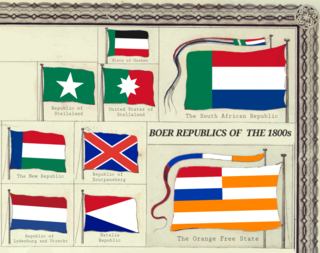
The Boer republics were independent, self-governing republics formed by Dutch-speaking inhabitants of the Cape Colony and their descendants. The founders – variously named Trekboers, Boers and Voortrekkers – settled mainly in the middle, northern, north-eastern and eastern parts of present-day South Africa. Two of the Boer republics achieved international recognition and complete independence: the South African Republic and the Orange Free State. The republics did not provide for the separation of church and state, initially allowing only the Dutch Reformed Church, and later also other Protestant churches in the Calvinist tradition. The republics came to an end after the Second Boer War of 1899–1902, which resulted in British annexation and later incorporation of their lands into the Union of South Africa.

Potchefstroom, colloquially known as Potch, is an academic city in the North West Province of South Africa. It hosts the Potchefstroom Campus of the North-West University. Potchefstroom is on the Mooi Rivier, roughly 120 km (75 mi) west-southwest of Johannesburg and 45 km (28 mi) east-northeast of Klerksdorp.
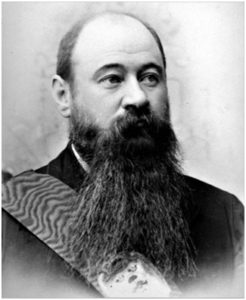
MartinusTheunis Steyn was a South African lawyer, politician, and statesman. He was the sixth and last president of the independent Orange Free State from 1896 to 1902.
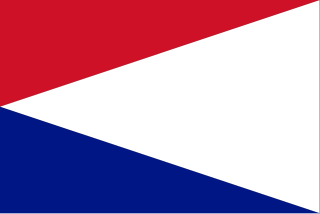
The Natalia Republic was a short-lived Boer republic founded in 1839 after a Voortrekker victory against the Zulus at the Battle of Blood River. The area was previously named Natália by Portuguese sailors, due to its discovery on Christmas. The republic came to an end in 1843 when British forces annexed it to form the Colony of Natal. After the British annexation of the Natalia Republic, most local Voortrekkers trekked northwest into Transorangia, later known as the Orange Free State, and the South African Republic.

Senekal is a town situated on the banks of the Sand River in the eastern part of the Free State province of South Africa. It was named after Commandant FP Senekal. It is the second largest town in Setsoto Municipality after Ficksburg, the largest town and capital of Setsoto. Senekal lies on the N5 national road between Winburg on the west and Bethlehem to the east. It has two townships, Matwabeng and OR Tambo Section, the latter being the latest, largest and fastest growing.

Winburg is a small mixed farming town in the Free State province of South Africa.
Heilbron is a small farming town in the Free State province of South Africa which services the cattle, dairy, sorghum, sunflower and maize industries. Raw stock beneficiation occurs in leisure foods, dairy products and stock feeds. It also serves as a dormitory town for the Gauteng metropolis.

Francis William Reitz, Jr. was a South African lawyer, politician, statesman, publicist, and poet who was a member of parliament of the Cape Colony, Chief Justice and fifth State President of the Orange Free State, State Secretary of the South African Republic at the time of the Second Boer War, and the first president of the Senate of the Union of South Africa.
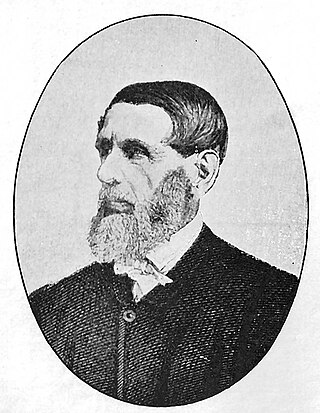
Jacobus Nicolaas Boshof was a South African (Boer) statesman, a late-arriving member of the Voortrekker movement, and the second state president of the Orange Free State, in office from 1855 to 1859.

The Battle of Boomplaats was fought near Jagersfontein at 29°50′53.47″S25°38′56.54″E on 29 August 1848 between the British and the Voortrekkers. The British were led by Sir Harry Smith, while the Boers were led by Andries Pretorius. The British were victorious after one Boer opened fire too early and betrayed their position.
Johan Arnold Smellekamp was a Dutchman who pioneered trade with the Boer Voortrekker states in South Africa and later became a civil servant, politician and law agent in the Orange Free State.

Pieter Hendrik Kritzinger, was a Boer general and Assistant Commandant of the Forces of the Orange Free State and Commander-in-Chief of the Boer Rebel Forces in the Cape Colony and noted guerrilla commander during the Second Boer War who led the Boer invasions of the Cape Colony during the Guerilla Phase of the Second Boer War.
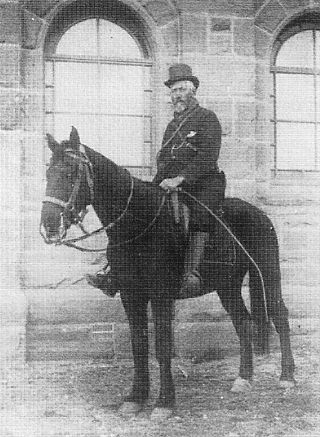
Christoffel Cornelis Froneman, commonly known as Stoffel Froneman, was veldkornet, general and Vice-Commander-in-Chief of the Orange Free State Boer forces during the Anglo-Boer War of 1899-1902.
Schoemansdal was a settlement situated 16 km west of Louis Trichardt (Makhado), which had its origins during the Great Trek. It existed from 1848 to 1867, and functioned as the capital of an autonomous region until the S.A.R. Volksraad was established, when the outpost came under the supervision and regulations of the central government. The settlement was evacuated after only thirty years when attacked by Venda militants. The government rendered indecisive support and the town as torched by Katze-Katze on the night of 15 July 1867.

Belmond Mount Nelson Hotel is a luxury hotel situated in the Gardens neighbourhood in inner-city Cape Town in a garden estate overlooked by Table Mountain.

The Jamia mosque or Queen Victoria mosque is situated at the corner of Chiappini and Castle street, Cape Town. It is considered to be the first and oldest mosque in Cape Town, and the largest in the Bo-Kaap area of Cape Town.

The Old Parsonage Museum in Fraserburg is the first parsonage that the Fraserburg Reformed Church, the local congregation of the Dutch Reformed Church in South Africa (NGK), built for its pastor, five years after the congregation's founding in 1851. It has for many years housed the local museum and is one of three national heritage sites in the Karoo town. Its restoration around 1979 was the largest of several projects in the region carried out around that time, including that of the Peperbus, a former Anglican church and gunpowder magazine.
The Fordsburg Reformed Church was a congregation of the Dutch Reformed Church in South Africa (NGK) that served the western Johannesburg suburb of Fordsburg from November 6, 1896, to 1988.
The Pietermaritzburg Reformed Church was a congregation of the Dutch Reformed Church in South Africa (NGK) in Pietermaritzburg, the capital of KwaZulu-Natal, but after the sale of the congregation’s downtown building, its centre shifted to what is now Howick. It was the first congregation founded by Voortrekkers after they left Cape Colony and the 25th oldest congregation in the NGK. The congregation’s membership, however, declined by around two-thirds, from 752 in 2000 to 256 in 2015.